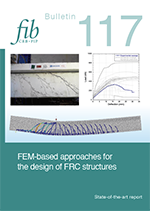No. 117. FEM-based approaches for the design of FRC Structures - State-of-the-art report (268 pages, ISBN 978-2-88394-195-3, August 2025).

Title: FEM-based approaches for the design of FRC Structures
State-of-the-art report
Year: 2025
Pages: 268
Format approx. DIN A4 (210x297 mm)
ISBN: 978-2-88394-195-3
DOI: doi.org/10.35789/fib.BULL.0117
Abstract:
Fibre Reinforced Concrete (FRC) has emerged as a key material innovation in structural engineering, offering enhanced performance in terms of post-cracking capacity, durability, and serviceability. The addition of discrete fibres to cementitious materials enables the development of structures with improved residual strength, reduced crack widths, and, in some cases, the partial or total replacement of conventional reinforcement, with both technical and economic advantages.
Within fib Commission 2 (COM2) Analysis & Design, which is dedicated to advancing analysis and design methods for structures, Working Party 2.4.1 “Modelling of fibre reinforced concrete structures” aims to address the challenges and opportunities that fibre reinforcement introduces into structural analysis and design. As analysis gains increasing importance in structural engineering, particularly through the use of refined models with strong theoretical basis, this document aligns with COM2’s mission to provide comprehensive, reliable models and procedures for both new and existing structures. It does so in support of serviceability and ultimate limit state verifications.
Traditional design methods for reinforced concrete, which neglect the tensile capacity of concrete, are inadequate for FRC. Fibre reinforcement mechanisms act primarily after crack initiation, and the structural benefit is closely tied to the post-cracking tensile behaviour of the material. As a result, fibre reinforcement must be considered in the design of structural members subjected to flexure, shear, torsion, punching, and serviceability limit states such as deflection and crack width.
This document presents a state-of-the-art overview of numerical models for simulating FRC behaviour at both the material and structural levels. Emphasis is placed on the application of Finite Element Method (FEM)-based approaches, especially nonlinear finite element analysis (NLFEA), which are essential for capturing crack formation, crack propagation and the fibre bridging effects. Both Explicit Fibre Reinforcement Approaches (EFRA), where fibres are modelled individually, and Implicit Fibre Reinforcement Approaches (IFRA), where their contribution is integrated into the constitutive behaviour of the cracked concrete, are reviewed in detail.
The practical application of these advanced modelling techniques poses challenges for engineers, including the selection of appropriate models, the calibration of model parameters, and the transfer of experimental data to structural design scale modelling. To support engineers in this process, this document discusses model performance on small-scale test simulations and real-world structural applications. In doing so, it contributes to COM2’s goal of bridging the gap between detailed analysis and practical design.
Readers are encouraged to consult fib Bulletin 45 Practitioner’s guide to finite element modelling of reinforced concrete structures before engaging with this document. Bulletin 45 provides essential background on nonlinear FEM modelling for conventional reinforced concrete, which is assumed as a foundation here. Building on that knowledge, this document focuses on the specificities introduced by fibre reinforcement.
By fostering a deeper understanding of fibre behaviour and its modelling, bulletin 117 aims to support both research and practice in structural engineering, reflecting COM2’s commitment to rigorous analysis and applicable design methodologies.
COM2 Chair Oguzhan Bayrak
Download the copyright page (= list of authors) as a PDF file.
Download the table of contents as a PDF file.